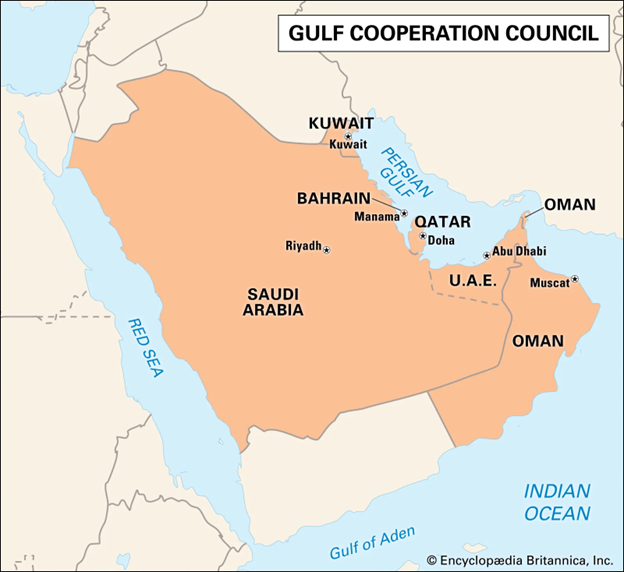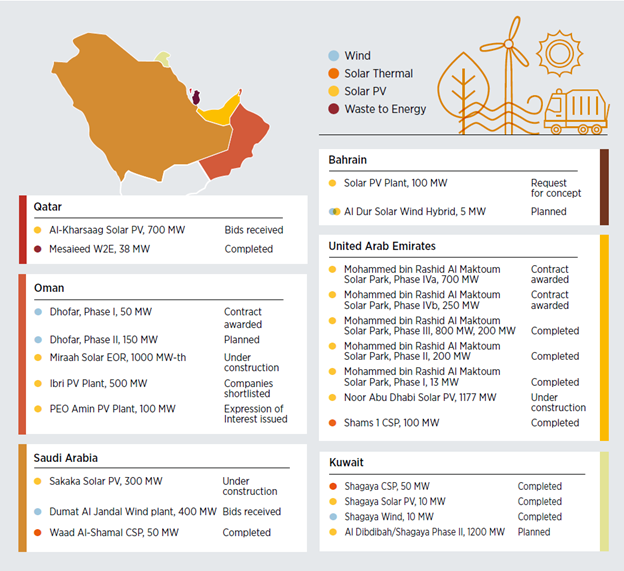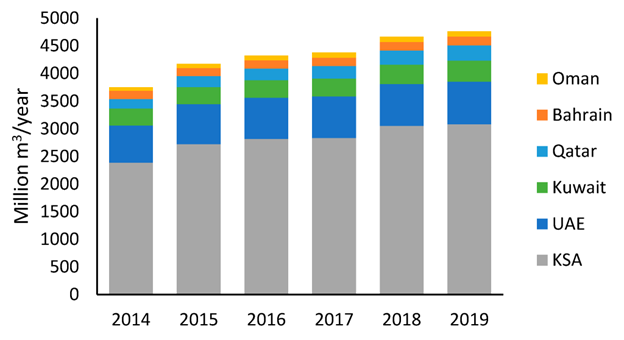Traditional energy nations in the Arabian Gulf are embracing renewables more quickly than ever. The region has become crucial to global efforts in support of the energy transition.
About Global and Gulf Energy Issues
Overview
The Gulf Cooperation Countries (GCC, i.e. Bahrain, Saudi Arabia, Kuwait, Oman, Qatar, and the United Arab Emirates) rely significantly on oil export revenues to meet their budgetary needs and therefore face a potentially challenging future should a low-carbon energy transition result in a concrete reduction in global oil demand [1]. Gulf oil nations have resisted Western powers’ efforts to gradually wean themselves off their dependence on hydrocarbons, arguing that doing so would be harmful. However, the Gulf states are starting their own large-scale clean energy projects as they proclaim to the world that they cannot survive without the natural resource that has brought them immense wealth.
Traditional energy-producing nations in the Persian Gulf are embracing renewables more quickly than ever as world leaders turn to them as a solution to the escalating and multifaceted danger posed by climate change. The Gulf Arab countries have grown to be essential to international efforts to promote energy transformation, led by initiatives in Saudi Arabia and the United Arab Emirates.
Some of the world’s largest oil and gas producers and exporters, GCC are also among the globe’s biggest polluters. Oil-rich Saudi Arabia and gas-abundant Qatar have some of the most problematic carbon footprints on the planet. The World Bank highlights Qatar’s carbon emissions per capita as the highest of 2019, followed by Kuwait, Bahrain, the United Arab Emirates and the Kingdom of Saudi Arabia.

Figure 1. The President of the UAE and Ruler of Abu Dhabi at the Shams 1 Concentrated Solar Power plant during the opening ceremony. Source: https://helioscsp.com/masdars-shams-1-concentrated-solar-power-plant-now-powers-20000-homes/
The Gulf monarchies are trying to reverse that by investing billions in the renewable energy sector. By doing so, they save more of their hydrocarbons for export to an energy-hungry world. Yet, some analysts say the measure is more than a publicity stunt in a world where oil is increasingly stigmatized. It is pragmatic, they say. It is also possible to enhance their hydrocarbon assets for export and take advantage of a window of opportunity as demand is anticipated to fall gradually; the Gulf states are working towards net zero domestic targets in various respects [2].
According to Sultan Al Jaber, the CEO of the UAE’s leading oil company ADNOC, who also happens to be the government’s climate envoy, “society needs all the solutions it can get”. The Emirates were the first Middle Eastern state to add nuclear to its energy mix and the first to set a net-zero emissions goal by 2050. The Emirates are home to the International Renewable Energy Agency (IRENA) headquarters and are due to host next year’s COP28 climate summit.
Getting on board, Saudi Arabia, which has its own climate policy, declared a 2060 net zero emissions goal. The Public Investment Fund, the $620 billion wealth fund headed by Crown Prince Mohammed bin Salman, recently stated that it will aim for zero net emissions by 2050. He also announced that the Kingdom would contribute $2.5 billion to the Middle East Green Initiative, which aims to cut carbon emissions from regional hydrocarbon production by more than 60%.
Why Countries in the Gulf are Turning to Renewables
It is entirely possible to produce enough affordable, dependable electricity from renewable sources. It is not only possible but also the best course of action given that it would have more socioeconomic advantages than continuing with business as usual and would enable us to combat climate change effectively.
Here are five reasons why Gulf Arab countries are turning to renewables [3]:
Renewables are the most reasonable and readily available climate solution
According to IRENA [4], the accelerated deployment of renewable energy in the Arabian Gulf can reduce carbon emissions by 136 million tonnes of CO2. As governments are being urged to step up their clean energy targets to keep the atmosphere well below 2° Celsius of warming, the UAE has more than doubled its current pledge, committing to 50 per cent low-carbon generation by 2050 at the UN Climate Action Summit in New York, resulting in even more CO2 reductions than anticipated.
Renewable energy creates jobs
The growth of jobs in the renewable energy sector can be facilitated by long-term policy goals seen in the Gulf area, including private entrepreneurship, education, training, and investment in local skills and human resources. According to IRENA’s projections, solar technologies will likely account for 89% of the region’s new jobs from renewable energy by 2030. By 2030, just the growth of rooftop solutions in the area might employ 23,000 people.
The region is endowed with considerable renewable energy potential – and not just solar
The suitability analysis for solar PV technology in the Gulf region reveals strong potential for deployment in all Arab countries, with Oman, Saudi Arabia, and UAE as leaders. Furthermore, areas in Kuwait, the Kingdom, and Oman also boast good wind resources. Technologies like geothermal power and biomass may hold additional potential but remain underexplored. The mid-term could result in about 72 GW of renewable energy capacity in the Gulf by 2030.
Renewable energy is the most competitive form of power generation in the region
The Gulf’s move to renewable energy is driven mainly by the business case for them. The most cost-effective source of new power generation in these nations today is renewable energy, displacing conventional energy sources to solve the region’s rapidly expanding domestic demand. Recently, the Mohammed Bin Rashid Al Maktoum Solar Park’s 900-megawatt fifth phase in the United Arab Emirates earned one of the lowest bids for a solar PV project in the world at 1.7 cents per kilowatt hour (kWh) [5].
Water conservation
Water scarcity is an acute problem in the region, with four of the six Gulf Arab countries ranking within the top 10 most water-scarce on earth, according to the World Resources Institute. Additionally, the region’s need for water is anticipated to more than double by 2050 due to one of the fastest rising populations in the world. If the Gulf states were to achieve their green energy targets, this would lead to an estimated overall reduction of 17% and 12% in water withdrawal and consumption, respectively, in the power sectors of the region. Much of this reduction would be in the UAE and the Kingdom of Saudi Arabia due to their ambitious plans concerning renewables expansion.
The State Of The Energy Transition
The Geopolitics
The Gulf Arab States’ geographical location serves as the point that links the West to the East. The region is located in the Arabian Peninsula, southwest of Asia, and covers a large area of desert that occupies most of the Arabian Peninsula wilderness in western Asia. In addition, the area overlooks three important waterways: the western Red Sea, the eastern Arabian Gulf, and the southern Arabian Sea.
The main Arabian Gulf is composed of the Straits of Hormuz in the inner Arabian Gulf and Oman Gulf, that is, the outer Gulf. The Red Sea front brings the region in contact with the Suez Canal in Egypt, which links the Red with the Mediterranean Sea.
The facts of geography and the region’s strategic location are points in the Arabian Gulf countries’ favour, and they have vast amounts of natural resources.

Figure 2. The Gulf Arab States or Gulf Cooperation Council (GCC) is a political and economic alliance of six Middle Eastern countries. Source: https://www.britannica.com/topic/Gulf-Cooperation-Council
To counter the many challenges associated with the clean energy transition, Gulf Arab states need to forge strong bilateral relationships that will yield security of energy demand as well as new economic opportunities that arise from a low-carbon energy transition. The UAE is a country that has been expanding strategic bilateral relationships regionally and globally in an effort to position such an energy transition effectively.
Predicting the ultimate extent of a low-carbon energy system transition and the pace at which it will occur is a somewhat complex matter that depends on multiple socio-political factors [6]. Nonetheless, current trends point toward a significant increase in renewable energy in the power sector by the middle of this century, coupled with substantial advances in transportation electrification.
Although there is increasing agreement that an “energy transition” is taking place, social and political variables will play a significant role in determining how widely renewable energy technologies are implemented. Among the numerous published global energy outlooks, those disclosed by the Institute of Energy Economics, Japan (IEEJ) [7] and Equinor [8] are two that provide insight into how such a low-carbon energy transition may evolve differently based on uncertain social, economic and political dynamics that may develop globally in the coming years.
Although Arabian Gulf countries have historically had access to cheap and abundant natural gas and oil supplies to meet their domestic energy demands, this situation has changed in recent years. While oil remains abundant, with the region accounting for about 30% of proven crude oil reserves and 28% of oil exports globally, all countries, except for Qatar, have experienced a shortfall of domestic natural gas production to meet growing domestic demands. This shortfall in regional natural gas supply has triggered countries throughout the Gulf to explore their options for increasing natural gas supply and reducing natural gas demand.
Despite its abundant natural gas resources, Qatar’s political differences with Saudi Arabia, Bahrain and the UAE have made it impossible for it to be a key natural gas supplier across the Gulf. Instead, bilateral energy relations between Gulf Arab states are currently limited to pipeline natural gas exports from Qatar to both the UAE and Oman via the Dolphin pipeline and liquefied natural gas (LNG) shipments to Kuwait.
Given this situation, countries are pursuing the development of their own indigenous natural gas resources as well as the deployment of clean energy, including both nuclear and renewables, to achieve domestic energy security at the lowest possible cost. Although the procurement and domestic deployment of renewable energy is unlikely to have any significant implications for bilateral diplomatic relations, the development of challenging sour and shale natural gas resources, as well as the deployment and operation of nuclear energy, requires significant foreign engagement for access to specialized skills and technologies.
Wind & Solar Deployment
The development of wind and solar energy projects has been relatively low in spite of the significant geographical potential, which could provide effective solutions to expected electricity demand growth, unprecedented high energy costs, and climate change issues.
The importance of implementing large-scale photovoltaic (PV), concentrating solar power (CSP) and other solar energy applications and their economic benefits across the Arab states’ territories have been analyzed and documented. Based on the geographic location and the annual insolation, the region is among those with the highest solar potential in the world. The yearly average global solar radiation in the Persian Gulf surroundings is estimated at 6 kWh/m2 per day, and the direct normal irradiance is around 4.5 kW/m2 per day.
A major milestone in the region was the off-grid solar electrification of two Saudi villages, namely, Al-Jubaila and Al-Uyaina, in the early 1980, followed by several other ad-hoc solar projects over the course of three decades.

Figure 3. Renewable energy projects in the GCC at the end of 2018. Source:
The power generation from wind energy in the Gulf Arab countries is estimated to grow dramatically in the future. It is expected that this will introduce significant challenges, such as intermittency and unrecognized locations of high wind abundance. To promote wind energy implementation in the region, the Masdar Institute and other researchers have conducted several studies on the feasibility and potential of wind energy and other low-carbon technologies [9].
Looking forward, the region is set to see a significant acceleration in renewable energy deployment. Led by the UAE, Oman and Kuwait, nearly 7 GW of new renewable power generation capacity is expected to come online soon (Figure 3). Solar PV is the dominant technology, used in three-fourths of currently planned renewable projects, followed by CSP (about 10%, all in a single project in the UAE) and wind (9%), primarily in Saudi Arabia and Oman. Solar-assisted EOR in Oman is also expected to contribute approximately 1 GWth.
The Role of Biomethane
Municipal wastewater production has been growing consistently at a 5% annual pace (Figure 4). As of 2019, the GCC region as a whole generated around 4763 106 m3 of wastewater, with Saudi Arabia and the UAE contributing 65% and 16%, respectively, of that total volume. Wastewater treatment facilities and renewable energy production can be integrated into the sector by managing wastewater sludge for energy recovery.
Recent findings [10] demonstrate the vital role of biogas and biomethane as renewable fuels in transitioning the energy and water systems within the Arabian sea, together with highlighting the importance of diverting organic substrates from landfills to avoid methane release. The biomethane potential for the region’s quantified sludge ranges between 230–332 × 106 cubic metres, with a total calorific value of up to 10.7 trillion BTUs per annum.
The obtainable biomethane can generate more than 1600 GWh of electricity, equivalent to the current levels of electric output from solar and wind power combined. A connected case study on Kuwait points out that biomethane could replace 13 × 106 cubic metres of natural gas, or approximately 85,000 barrels of crude oil, together with reducing GHG emissions by more than 85% compared to the baseline scenario.
Moreover, biomethane can serve as a flexible and renewable energy source to uphold a reliable power supply with the lowest carbon emissions, allowing greater shares of variable energy sources (solar and wind) to be integrated into the power systems.

Figure 4. Gulf Arab states wastewater influent. Source: https://www.mdpi.com/2076-3417/11/21/10275
Outcomes
For the Gulf, renewables support economic diversification and reinforce energy security whilst offering nations rich in solar resources an opportunity to explore their hidden economic potential. They also offer a second chance at leadership within the energy world.
Today, many global cost reductions witnessed in renewables have shown up in the Gulf Arab states. And by driving down the price of renewables and investing abroad, the Gulf is also shaping the energy transition in other regions.
References
[1] Economic diversification in oil-exporting Arab countries. IMF. Annual Meeting of Arab Ministers of Finance, International Monetary Fund (IMF) (2016)
[2] Gulf Arab states can’t give up oil. But they can slash their emissions | CNN Business
[3] Five Reasons Why Countries in the Gulf are Turning to Renewables
[4] IRENA (2019), ‘Renewable Energy Market Analysis: GCC 2019’. IRENA, Abu Dhabi.
[5] Race Heats Up For Title Of Cheapest Solar Energy In The World
[6] Griffiths, S. (2019). Energy diplomacy in a time of energy transition. Energy Strategy Reviews, 26, 100386.
[7] Prospects and Challenges until 2050. IEEJ, IEEJ Outlook. The Institute of Energy Economics Japan (IEEJ), Tokyo, Japan (2018), p. 2017
[8] Energy Perspectives. Equinor (2018), p. 2018
[9] https://masdar.ae/Masdar-Clean-Energy/Technologies/Wind
[10] Alshawaf, M.; Alsulaili, A.; Alwaeli, M.; Allanqawi, H. The Role of Biomethane from Sewage Sludge in the Energy Transition: Potentials and Barriers in the Arab Gulf States Power Sector. Appl. Sci. 2021, 11, 10275. https://doi.org/10.3390/app112110275

 To all knowledge
To all knowledge